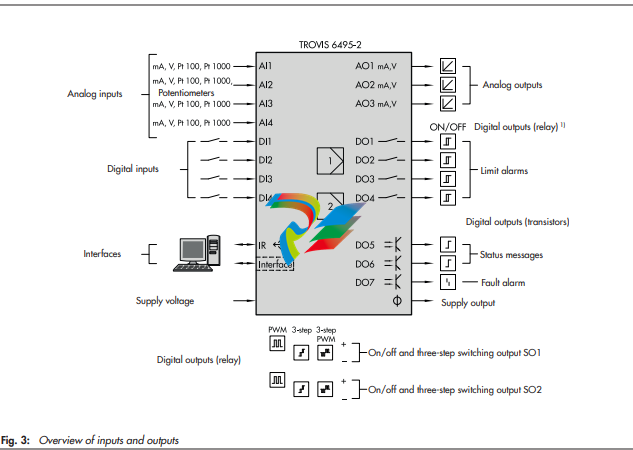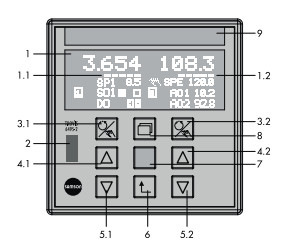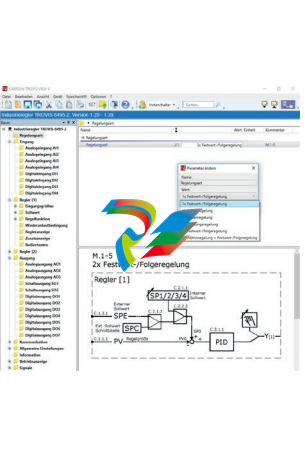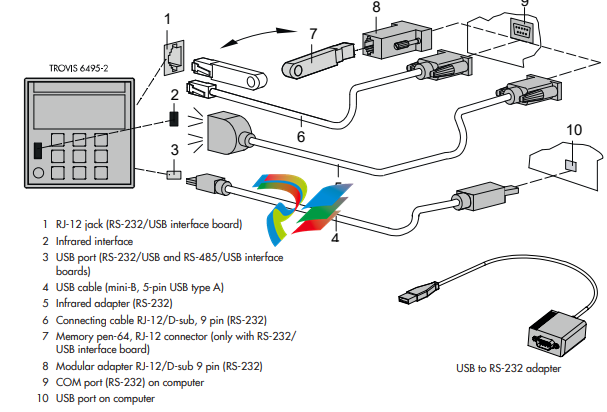
samsonT 6495-2 ENTROVIS 6495 Industrial Controller
− Switchover between internal set points
− Switchover to external set point
− Opening/closing cascade
− Incremental/decremental set point change
− Set point increase/decrease by constant
− Start set point ramp
− Hold set point ramp
− Invert error signal
− Control mode selection P(D)/PI(D)
− Activate operating point for P/PD controller
− Manual/automatic switchover
− Hold output
− Activate output tracking
− Increase/decrease actual value
− Activate constant output value
− Start output ramp
− Limit output rate
− Lock control keys
Outputs
− 3 analog outputs (AO1 to AO3)
The signal type is set depending on the configuration.
− 0/4 to 20 mA
− 0/2 to 10 V
The outputs AO1 to AO3 can optionally be used for other
signals as well.
− 7 digital outputs (4 relay outputs and 3 transistor
outputs)
The relay outputs can be used as follows:
− SO1 and SO2 as on/off or three-step output
− DO1 to DO4 as limit output
− DO5 and DO6 (transistor output) for status messages
− DO7 (transistor output) for fault alarms
− 4 relay outputs
for two on/off or three-step outputs or four limit alarms
− 2 transistor outputs
for status messages
− 1 transistor output
for fault alarms
− 1 supply output
The supply output can be used to supply a voltage for up
to 4 two-wire transmitters and 4 digital inputs (21 V DC,
max. 90 mA).
Infrared interface
Data are transmitted between the controller and the TROVISVIEW software over an infrared interface, by default
integrated into the controller and an infrared adapter (order
no. 8864-0900) connected to a computer (see the Mounting
and Operating Instructions EB 6495-2).
Communication interface
Optionally, the controller can be equipped with one of the following interface boards. The boards can also be retrofitted.
− RS-232/USB interface board
− One RS-232 interface with RJ-12 jack
− One USB interface with 5-pin mini-B port
The RS-232 data transfer uses an SSP or Modbus RTU
protocol. The memory pen-64 can be used with controllers
fitted with an RS-232/USB interface board to load data
configured in TROVIS-VIEW or transferred from another
controller.
− RS-485/USB interface board
− RS-485 interface (4 terminals) and
− USB interface (5-pin mini-B port)


Operation
Display and operating controls
The device has nine operating keys, of which three are assigned to each controller channel. Depending on the selected
control type, one or two controllers are activated. The readings and controls of the controller [1] are located on the left
half of the device and on the right half for controller [2] (or
optionally vice versa). The row of keys in the middle is used
for both controllers.
Fig. 5: Display and operating controls
Operating level
After the supply voltage has been switched on, the controller
is in operating level.
The readings of the controlled variable, the reference variable
and the manipulated variable for each controller as well as a
bar graph for error are indicated on the display (1). Depending on the configuration, status alarms of the digital inputs
and outputs can be shown. The operating menu allows set
points to be switched and control parameters to be changed.
The two rows at the bottom of the display can be assigned as
desired. Numerous signals and interim outputs relating to the
internal controllers can be selected. For example, the values or
a bar graph of two outputs in split-range operation can be
displayed.
Configuration and parameterization
The controller is adapted to the selected application in the
configuration level. The configuration items are arranged in
hierarchical menus. All settings are displayed as plain text.

Operation using TROVIS-VIEW
Controller settings (see Fig. 6)
Configuration settings and parameters can conveniently be
adjusted, documented and transmitted using the optional
TROVIS-VIEW software. Working in TROVIS-VIEW is similar
to working in Windows® Explorer. TROVIS-VIEW includes a
trend viewer for start-up that records the process data. Input
and output variables are displayed in a clear structure.
The TROVIS-VIEW software can be delivered on a CD-ROM,
if required. For further information on TROVIS-VIEW refer to
Data Sheet T 6661.
Data transmission (see Fig. 7)
Î Ordering numbers (see Table 3)
Data can be exchanged between the TROVIS-VIEW software
and the controller in various ways:
– Data transmission using the infrared interface (11) and an
infrared adapter (14)
– Data transmission using the optional interface board with
RS-232 and USB connections: data can be transmitted
over a conventional cable connection (either with a USB
cable (13) or a connecting cable (15)) or using a memory
pen (16).
– To integrate the controller into a communications network,
the controller can be fitted with an optional RS-485 interface board. The interface board has a USB connection
which can be used to transfer data using TROVIS-VIEW






























































































































